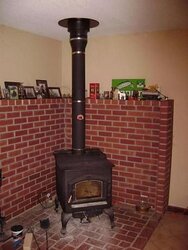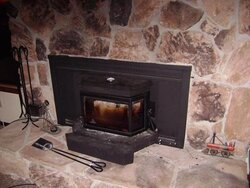If you have problems people criticize your installation, wood or operating methods.
I had problems so I did experiments, since I wasn’t getting helpful information.
A great plus point is I have two systems to do A/B comparisons.
WOOD STOVE in den. INSERT in fireplace in living room. Both installed within the last year. All done to code and manufactures specs. Both in single level house. Fairly open floor plane between the two rooms. Never operated at same time.
Average temperature at evening start, 55 F inside, 45 F outside.
No wind or rain. Black print newspaper, commercial bundle of thin pine kindling.
Tests done with Ecco logs or Presto Logs. All stored inside.
Basically it just doesn’t get any better as far as perfect and repeatable conditions.
INSERT has shallow box and bay window door. Fire is forward toward large bay window door. This sounds like it could be a problem but even starting cold it doesn’t smoke with the door all the way open. Starts easily. But relative to it’s size doesn’t put out much heat. Air wash keeps windows fairly clean
The WOOD STOVE is deep. The fire can be far back and the door is small. This has a constant smoking problem. You can’t open the door more than a few inches. Hard to start. Air wash does nothing to keep window clean
Sometimes it appears to have a blocked pipe. Intermittently even with a flash newspaper and kindling it starts going out and opening the door slightly only lets smoke out and no air goes in to perk up the fire. But if it ever does get going, it puts out three times the heat for same amount of wood, compared to the INSERT.
Same house, same level, same newspaper, same kindling, same test wood (presto logs), same operator, same weather and temperature.
The wood stove has a smoking problem, but also intermittently appears to get blocked completely. But here is the real fun part. The intermittent problem appears occasionally on week days only. Never on weekends. Since it is all the same and darn near perfect, people can’t say problems are related to; my installation, wood or operating method. It’s all the same and yet two different EPA approved devices operate with greatly different plusses and minuses.
Now let’s see people make statements as to what the problems are. The purest say there is nothing wrong with these new designs. But the fact is two different devices act greatly different under the exact same conditions. I will grade your answers in a few days. GO!
I had problems so I did experiments, since I wasn’t getting helpful information.
A great plus point is I have two systems to do A/B comparisons.
WOOD STOVE in den. INSERT in fireplace in living room. Both installed within the last year. All done to code and manufactures specs. Both in single level house. Fairly open floor plane between the two rooms. Never operated at same time.
Average temperature at evening start, 55 F inside, 45 F outside.
No wind or rain. Black print newspaper, commercial bundle of thin pine kindling.
Tests done with Ecco logs or Presto Logs. All stored inside.
Basically it just doesn’t get any better as far as perfect and repeatable conditions.
INSERT has shallow box and bay window door. Fire is forward toward large bay window door. This sounds like it could be a problem but even starting cold it doesn’t smoke with the door all the way open. Starts easily. But relative to it’s size doesn’t put out much heat. Air wash keeps windows fairly clean
The WOOD STOVE is deep. The fire can be far back and the door is small. This has a constant smoking problem. You can’t open the door more than a few inches. Hard to start. Air wash does nothing to keep window clean
Sometimes it appears to have a blocked pipe. Intermittently even with a flash newspaper and kindling it starts going out and opening the door slightly only lets smoke out and no air goes in to perk up the fire. But if it ever does get going, it puts out three times the heat for same amount of wood, compared to the INSERT.
Same house, same level, same newspaper, same kindling, same test wood (presto logs), same operator, same weather and temperature.
The wood stove has a smoking problem, but also intermittently appears to get blocked completely. But here is the real fun part. The intermittent problem appears occasionally on week days only. Never on weekends. Since it is all the same and darn near perfect, people can’t say problems are related to; my installation, wood or operating method. It’s all the same and yet two different EPA approved devices operate with greatly different plusses and minuses.
Now let’s see people make statements as to what the problems are. The purest say there is nothing wrong with these new designs. But the fact is two different devices act greatly different under the exact same conditions. I will grade your answers in a few days. GO!




